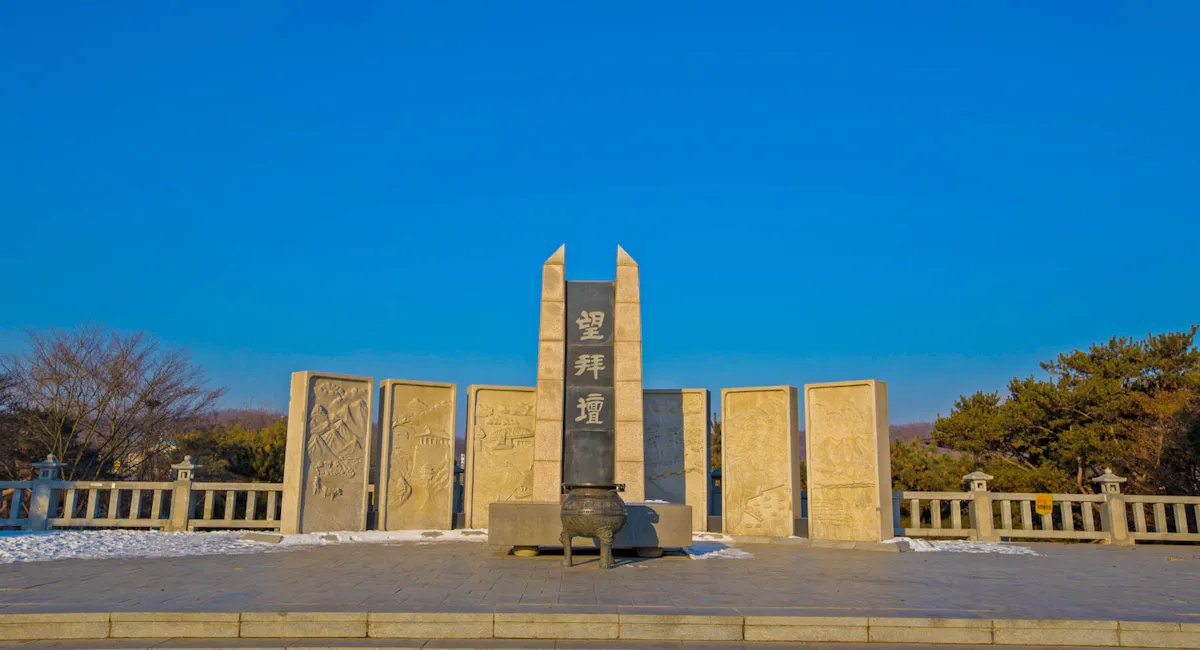Of all the places in the world which have become accessible over time due to better transport and cordial relations between nations, one country which has remained somewhat of a mystery is North Korea. The unusually secretive country has a tightly controlled tourist influx with just about 3000-4000 people visiting the city annually. One of the only ways to get a glimpse of the mysterious North Korea is via the DMZ tour.
Despite the heavy militarisation, the DMZ attracts over 1.2 million travelers each year, but that might change soon. North Korea and South Korea have entered into an agreement to start dismantling certain sections of the DMZ. In November 2018, the North Korean government demolished several guard posts along the border and shut off the Joint Security Area during the time as well. Given the current political climate, it's unclear what's in store for the DMZ in the future or just how much it will change in the years to come. If you're keen on visiting this special border barrier, we would recommend visiting South Korea as soon as you can and visiting the DMZ on the first day of your trip to avoid facing the closure of the JSA or the DMZ.
Our DMZ Tour blog aims to help you plan your visit from Seoul, with tips and hacks for a enjoyable day trip.
Korean Demilitarized Zone (DMZ)

The Korean Demilitarized Zone (DMZ) is a border barrier that divides the Korean Peninsula in half and serves as a buffer zone between North Korea and South Korea. The 250 km long and 4 km wide strip of land was established as a result of the 1953 Korean War Armistice Agreement and presently serves as a common meeting ground for the two nations to negotiate. These meetings and negotiations happen in the small Joint Security Area (JSA), near the western end of the zone. The security is much tighter around the JSA and there are restrictions for dress code and photography in this area as well. The no-man's-land is just 30 miles north of Seoul, the capital of South Korea, making the DMZ easily accessible for tourists in Seoul.
DMZ VS JSA - What is the difference?
There's some amount of confusion between the DMZ and the JSA. Let us clear the air.
The Korean Demilitarized Zone (DMZ) represents the area 2 km north and south of the Military Demarcation Line. The area is uninhabited by people and is home to historical attractions and rare ecology. The Joint Security Area (JSA) is a specific area within the DMZ which functions as a place of dialogue between the two countries and was also the place where the truce between North Korea and South Korea was officially signed. Also known as Panmunjom, the JSA is located on the Western border of the DMZ. Another important distinction is that unless your tour package specifically mentions both DMZ and JSA, you'll only be visiting one of these places since there are separate tours available for both places.
Why You Must Go On A DMZ Tour?

- The DMZ is a very interesting place for many reasons. Primarily, the fact that the DMZ is often described as one of the most volatile regions in the world and yet attracts millions of tourists speaks of its strange allure. The heavily guarded strip of land has many interesting sections that shed ample light on the area's creation and its controversial past.
- A trip to the DMZ is a great way to learn about Korean history and how the war between the two sides of the Korean Peninsula has affected the people in both countries. The guided tours are extremely educational and if you're lucky, you might even get a tour guide who is a North Korea detector and can provide you with unheard of insights about life on the other side of the border.
- The DMZ is one of the few active remnants of the cold war, which makes it extra special and serves as a reminder of the grim realities of war.
- With iconic places like the Imjingak Park, the Dorasan Observatory, the Freedom Bridge, the Dorasan Train Station, and the Third Infiltration Tunnel all open to public inside the DMZ, a visit to this border zone even more special.
DMZ Half Day Tour - Best DMZ Tour On The Internet!
Korean Demilitarized Zone Day Tour
Take a tour of the DMZ (Demilitarized Zone) along the border between North and South Korea and check out Korean War era tanks at the Imjingak Park, walk through the Third Infiltration Tunnel, and get a glimpse of North Korea from the Dorasan Observatory.
- Have a surreal experience at the Demilitarized Zone, a heavily guarded borderline scarring the Korean peninsula with its separation into North and South Korea.
- Visit the Imjingak Park built as a tribute to those who suffered the brunt of the Korean War and the Freedom Bridge where many hostages and prisoners were exchanged.
- Peep through binoculars into North Korea at the Dorasan Observatory and visit South Korea’s symbolic yet barely used getaway station to the North - the Dorasan Train Station.
- Walk through the Third Infiltration Tunnel built by the North Koreans in an attempt to launch a surprise attack on South Korea in the 1970s.
What To Expect On A Half Day DMZ Tour?

There's quite a lot to see in a DMZ tour and in our opinion, half a day is ample time to explore the special border area without skipping anything important. A half day DMZ tour will begin with a trip to Imjingak Park, which is located 7 km from the Demarcation Line. The park holds a lot of symbolic and sentimental value for residents of both nations since it serves to commemorate the families which were separated due to the division of North and South Korea. With over 400 exhibitions about North Korea, the Imjingak Park is one of the few places in the world where you can learn about the elusive nation. Located in the park is the Freedom Bridge which connects the two nations and was once used by South Koreans who returned to their nation post the signing of the armistice.
Post the Imjingak Park, you'll pass through the Unification Village and make your way to the DMZ Theatre and Exhibition Hall which is where you'll learn about the history of the war and division of Korea. Next up is a tour of the fascinating Third Infiltration Tunnel. The tunnel was dug up by North Koreans in an attempt to infiltrate South Korea and launch a surprise attack. After the tunnel, you'll make your way to the Dorasan Observatory. This is where you can use binoculars to catch a rare glimpse of the mostly hidden North Korea. Also located next to the observatory is the Dorasan Train Station, where trains are ready to run, with hopes to reunification of Korea. These are the basic areas most half day DMZ tours will include but there are optional landmarks and attractions you can head to by paying a little extra. These include the Pistol Shooting Experience, the Gyeongbokgung Palace and the Insadong Antique Alley.
DMZ Tour Highlights
JSA
Joint Security Area or Panmunjom, as it is more commonly referred to as, is the closest point a tourist can get to North Korea and features gift shops that sell original items from North Korea. The JSA is also the place where the original peace treaty between North Korea and South Korea was signed.
Freedom Bridge

The Freedom Bridge connects North and South Korea and was used by South Koreans to return home after the armistice was signed. The bridge is currently barricaded to prevent unauthorized access.
Imjingak Park
A park which was built to commemorate all the families which were separated as a result of the partition of Korea, the Imjingak Park now signifies hope that the two warring nations would reunite once again.
Third Tunnel of Aggression
Despite talks of peace, North Korea began digging tunnels to South Korea with the intent of launching a surprise attack in the 1970s. The longest of these tunnels was discovered in 1978 and was just 44 km from Seoul! Not recommended for people who suffer from claustrophobia, these narrow tunnels are a grim reminder of the plight of the military personnel who participated in the war between the two nations.
Dora Observatory

Get a glimpse of the mostly hidden North Korean landscape by peering through binoculars at the Dora Observatory. If the day is clear, you might get a glimpse of the Kaesong City and Kaesong Industrial Complex.
Dorasan Train station
Serving as a symbol of hope for the reunification of North and South Korea, the Dorasan Train Station is a brand new, international station with trains ready to depart! If you take the peace train from Seoul, this is the station where you'll get off.

Know Before Your DMZ Tour
DMZ Opening Hours
The DMZ tours don't operate on Monday and Korean Holidays. Although, if the Korean Holiday falls on a weekend, chances are that the tour will run anyway.
Good To Know
Bring Your Passport : Remember to bring your passport along for both the DMZ and JSA tour. You'll not be allowed to join the tour if you don't have your passport.
Dress Appropriately : While the DMZ tour doesn't have a strict dress code, the JSA tour does. The following items of clothing will NOT be accepted at the JSA tour:
Shorts, skirts and dresses that aren't knee length, sandals, flip-flops, T-shirts, ripped jeans, tank tops, exercise clothes, clothing with military style print, stretch pants or tights. To be safe, wear a collared shirt with regular jeans as civilian clothing is preferred.
Code of conduct : Given the military presence in the DMZ, you are expected to follow a strict code of conduct to avoid any trouble:
- Don't wave at the North Korean guards or signal them in any other way
- Don't click any pictures unless the guards give their consent of what you can take a picture of
- Stay with your tour guide and military escort at all times and comply with all their instructions. For your own safety, avoid wandering off on your own.
Going From Seoul To DMZ - Your Transport Options
The DMZ is located just 60 km from Seoul and can be reached through the following two options:
- Peace Trains: The DMZ peace train is the cheapest way to the DMZ. The train runs from Seoul to the Dorasan Train Station from Tuesday to Sunday. Once you reach the Dorasan Train Station, you can take a bus to visit the DMZ. Opting for the train is preferable is you aren't a fan of group tours since this gives you a little more leeway, although you still have to join the group tour once you reach the Dorasan Train Station. The peace train tour of the DMZ takes up the whole day and you won't have time to explore Seoul, which is possible with a half day DMZ tour.
- Organized tours: Organized tours are a great way to experience the DMZ since you'll be accompanied by a knowledgeable guide who knows everything about the border land. An organized tour is also great since you'll be picked up from your hotel in Seoul and dropped back after the tour is over. You can also visit the iconic JSA through an organized tour. Depending on how much time you have at hand, you can opt for a half day or a full day DMZ tour. While the cost will be more than the peace train option, an organized tour is easily the more convenient choice of the two.
Handy Tips For Your DMZ Tour
- The first thing to know about booking a DMZ tour is that the demand for it is always sky high and you shouldn't wait till the last moment to book your tour. To avoid facing disappointment, book your DMZ well in advance. The security clearance process takes around three days so ensure that you have enough time to reapply in case your request falls through for some reason.
- There have been a fair bit of political changes in both North Korea and South Korea and the DMZ and its future have been at stake as a result. If you're visiting Seoul, make it a point to visit the DMZ on the first day of your trip because there's no way to tell when the tour might be cancelled due to reasons beyond the tour operators' control.
- Another important consideration when booking a DMZ tour online is picking the one that best suits your needs and plan. There are half day tours, full day tours, DMZ only tours and tours where you'll be visiting both the DMZ and the JSA. The JSA is one of the most fascinating parts of the DMZ and a regular DMZ tour won't stop at the JSA. While booking your tour, check the itinerary to confirm all the stops.
- The DMZ and JSA are testaments to the complicated history of the two Korean nations and your time at these places will be more insightful if you opt for a guided tour. If you're lucky, your tour guide will be a North Korean defector who can shed some light on the elusive nation and tell you about life on the other side of the border.
- The DMZ is a place of national importance to both South and North Korea and visitors are expected to behave a certain way to maintain the sombierty of the place. The biggest way to do that is by following the dress code prescribed by the organizers. Refer to our 'know before you go' section to learn about the dress code you should abide by. Also, limit your interaction with the North Korean guards to nada, if possible.
- Due to the security concerns pertaining to the DMZ region, you'll have to leave your bags at the bus before starting the tour. Pack lightly and avoid bringing anything to the tour that you won't be comfortable leaving at the bus. You can take your camera and wallet to the tour and nothing else.
- It's better to be aware of where you are going during the DMZ tour, so we would recommend bringing a map along. Also, ensure that you don't consume alcohol before or during the tour since any untoward incident at the DMZ will be labelled an "international incident" and you don't want to be a part of that!
More Seoul Guides
Looking for more tours and tickets in Seoul? Here are a few you should consider to make your Seoul vacation soulful!






